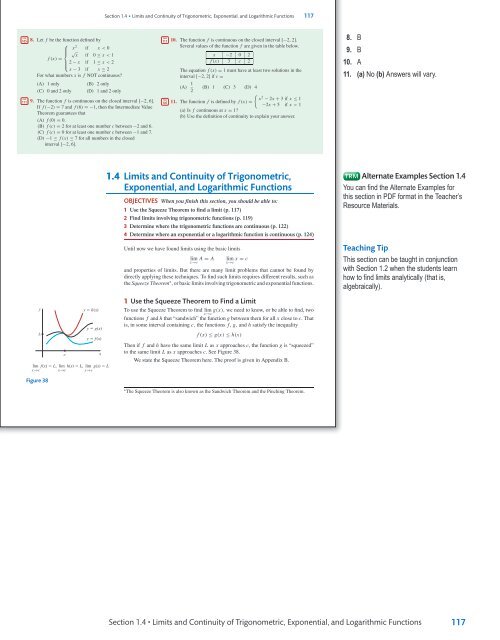Sullivan Microsite DigiSample
Create successful ePaper yourself
Turn your PDF publications into a flip-book with our unique Google optimized e-Paper software.
<strong>Sullivan</strong> AP˙<strong>Sullivan</strong>˙Chapter01 October 8, 2016 17:4<br />
Section 1.4 • Limits and Continuity of Trigonometric, Exponential, and Logarithmic Functions 117<br />
PAGE<br />
105 8. Let f be the function defined by<br />
⎧<br />
x<br />
⎪⎨<br />
2 if x < 0<br />
√ x if 0 ≤ x < 1<br />
f (x) =<br />
2 − x if 1 ≤ x < 2<br />
⎪⎩<br />
x − 3 if x ≥ 2<br />
For what numbers x is f NOT continuous?<br />
(A) 1 only<br />
(C) 0 and 2 only<br />
(B) 2 only<br />
(D) 1 and 2 only<br />
PAGE<br />
111 9. The function f is continuous on the closed interval [−2, 6].<br />
If f (−2) = 7 and f (6) =−1, then the Intermediate Value<br />
Theorem guarantees that<br />
(A) f (0) = 0.<br />
(B) f (c) = 2 for at least one number c between −2 and 6.<br />
(C) f (c) = 0 for at least one number c between −1 and 7.<br />
(D) −1 ≤ f (x) ≤ 7 for all numbers in the closed<br />
interval [−2, 6].<br />
PAGE<br />
111 10. The function f is continuous on the closed interval [−2, 2].<br />
Several values of the function f are given in the table below.<br />
x −2 0 2<br />
f (x) 3 c 2<br />
The equation f (x) = 1 must have at least two solutions in the<br />
interval [−2, 2] if c =<br />
(A)<br />
1<br />
2<br />
(B) 1 (C) 3 (D) 4<br />
PAGE<br />
105 11. The function f is defined by f (x) =<br />
<br />
x 2 − 2x + 3 if x ≤ 1<br />
−2x + 5 if x > 1<br />
(a) Is f continuous at x = 1?<br />
(b) Use the definition of continuity to explain your answer.<br />
8. B<br />
9. B<br />
10. A<br />
11. (a) No (b) Answers will vary.<br />
1.4 Limits and Continuity of Trigonometric,<br />
Exponential, and Logarithmic Functions<br />
OBJECTIVES When you finish this section, you should be able to:<br />
1 Use the Squeeze Theorem to find a limit (p. 117)<br />
2 Find limits involving trigonometric functions (p. 119)<br />
3 Determine where the trigonometric functions are continuous (p. 122)<br />
4 Determine where an exponential or a logarithmic function is continuous (p. 124)<br />
Until now we have found limits using the basic limits<br />
lim<br />
x→c A = A<br />
lim x = c<br />
x→c<br />
and properties of limits. But there are many limit problems that cannot be found by<br />
directly applying these techniques. To find such limits requires different results, such as<br />
the Squeeze Theorem ∗ , or basic limits involving trigonometric and exponential functions.<br />
TRM Alternate Examples Section 1.4<br />
You can find the Alternate Examples for<br />
this section in PDF format in the Teacher’s<br />
Resource Materials.<br />
Teaching Tip<br />
This section can be taught in conjunction<br />
with Section 1.2 when the students learn<br />
how to find limits analytically (that is,<br />
algebraically).<br />
y<br />
L<br />
c<br />
y h(x)<br />
y g(x)<br />
y f (x)<br />
lim f(x) L, lim h(x) L, lim g(x) L<br />
x→c x→c x→c<br />
x<br />
1 Use the Squeeze Theorem to Find a Limit<br />
To use the Squeeze Theorem to find lim<br />
x→c<br />
g(x), we need to know, or be able to find, two<br />
functions f and h that “sandwich” the function g between them for all x close to c. That<br />
is, in some interval containing c, the functions f, g, and h satisfy the inequality<br />
f (x) ≤ g(x) ≤ h(x)<br />
Then if f and h have the same limit L as x approaches c, the function g is “squeezed”<br />
to the same limit L as x approaches c. See Figure 38.<br />
We state the Squeeze Theorem here. The proof is given in Appendix B.<br />
Figure 38<br />
∗ The Squeeze Theorem is also known as the Sandwich Theorem and the Pinching Theorem.<br />
Section 1.4 • Limits and Continuity of Trigonometric, Exponential, and Logarithmic Functions<br />
117<br />
TE_<strong>Sullivan</strong>_Chapter01_PART I.indd 14<br />
11/01/17 9:58 am




